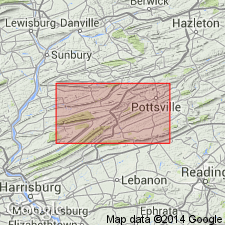
- Usage in publication:
-
- Beckville Member*
- Modifications:
-
- Named
- Dominant lithology:
-
- Conglomerate
- Sandstone
- Siltstone
- Shale
- AAPG geologic province:
-
- Appalachian basin
Summary:
Named Beckville Member of the Pocono Formation for Beckville, Schuylkill Co., PA. Consists of fine to coarse quartz-pebble conglomerate that is overlain by intercalated beds of fine pebble conglomerate, conglomeratic sandstone, quartzose sandstone, subgraywacke, siltstone, shale, and a few thin lenses of anthracite. Basal unit of member is 18 feet thick and consists of very light gray to light-olive-gray quartz-pebble conglomerate that rests on a 30-foot unit of light-olive-gray dark-brown weathering shale and siltstone of the Spechty Kopf Member of the Catskill Formation. The Beckville is 544 feet thick at the type section and is 800 feet thick in the vicinity of Lykens. Unit underlies the Mount Carbon Member of the Pocono Formation. It is of Early Mississippian age.
Source: GNU records (USGS DDS-6; Reston GNULEX).
For more information, please contact Nancy Stamm, Geologic Names Committee Secretary.
Asterisk (*) indicates published by U.S. Geological Survey authors.
"No current usage" (†) implies that a name has been abandoned or has fallen into disuse. Former usage and, if known, replacement name given in parentheses ( ).
Slash (/) indicates name conflicts with nomenclatural guidelines (CSN, 1933; ACSN, 1961, 1970; NACSN, 1983, 2005, 2021). May be explained within brackets ([ ]).

